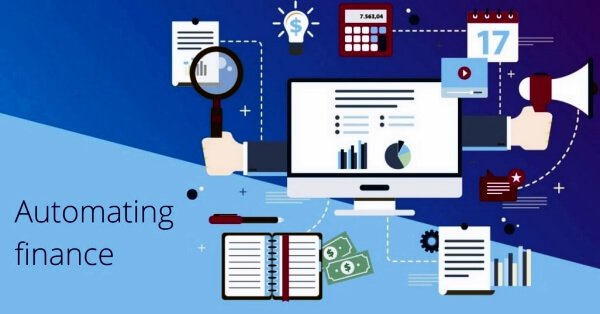Automate your finances to feel less overwhelmed by bills, budgeting, and tracking of your finances. In today’s tech-driven world, automating your finances is the key to simplifying your money management and achieving financial freedom. You’re not alone. Financial management can be a time-consuming hassle.

Automate Your Finances Meaning
To automate your finances, use technology to create automated money management systems. Envision having a dedicated financial assistant who handles tedious, behind-the-scenes work. Here are a few examples of what financial automation may accomplish:
- Pay bills automatically to avoid missing deadlines and paying late fees.
- Transfer funds to savings automatically: With automated transfers, you can easily accumulate an emergency fund or save money for a specific aim.
- Monitor your expenditures and create a budget on autopilot: Allow budgeting applications to classify your transactions and point out areas where you can make savings.
- Consistently invest: To assist you in achieving your long-term financial objectives, schedule regular payments to your investing accounts.
- Debt payoff quicker: To achieve debt freedom sooner, set up automatic payments for your debt.
Related: Sustainable Spending: Making Eco-Friendly Choices That Save You Money

How To Fully Automate Your Finances
Automating finance is revolutionary. You can keep on track with your financial goals, manage your money more efficiently, and have more time to spare. The following steps will help you reach financial peace of mind and completely automate your finances:
Creating Financial Objectives:
- Plan Your Path: Establish your finances goals before automating. Do you have emergency funds, debt reduction as your first priority, or savings for that ideal trip? Your automation plan will be shaped by your aims.
Assemble Your Finances:
- Make a list of all the accounts you have for money, including credit card, investment, savings, and checking and savings. You can use this to determine which regions should be automated.
Accept Apps for Budgeting:
- Look for Your Ideal Fit: Examine financial applications such as Personal Capital, YNAB (You Need A Budget), and Mint. These apps track expenditure, classify transactions, and many include automatic capabilities.
Utilize Tools for Online Banking:
- Explore the Toolkit at Your Bank: The majority of institutions have integrated automation features. Seek alternatives for account transfers, investment contributions, and automated bill payments.
Pay Bills Automatically:
- Set up automatic payments for all of your recurring bills, including rent, utilities, phone plans, etc., to ensure that you never forget a deadline. This makes budgeting easier and removes the possibility of late penalties.
Set Up Autopilot Savings:
- Prioritize Yourself by setting up recurring transfers from your checking to savings accounts. This guarantees that, whatever your spending habits, you will consistently save towards your goals.
Security Is Important:
- Put Safety First: Opt for trustworthy banking apps and institutions that have strong security features like two-factor authentication.
- Monitor Transactions Frequently: Remain alert by checking your automated transactions to make sure everything is correct and to spot any unusual activity.
Related: Financial Goals: Tips To Boost Your Bank Account

Principles Of Money Management
The cornerstone of sound financial management is understanding money. It’s the skill of managing your finances—income, outgoings, savings, and investments—well. You can take charge of your money, accomplish your objectives, and create a safe future by grasping these fundamental ideas.
Understand Your Position:
- It’s important to keep an eye on your income and expenses. To keep track of all of your revenue and allocate your expenses, make a budget. You can now track your spending and find areas for improvement thanks to this.
- Determine Your Net Worth by subtracting your obligations from your assets (i.e., what you own) (what you owe). Monitoring your net worth over time reveals your growth in terms of money.
Keep Yourself Within Your Means:
- Avoid Overspending: As income improves, try not to let spending grow along with your lifestyle. Try to stay out of debt and spend less than you make.
- Put Needs Before Wants: Make a distinction between permanent needs (such as food, shelter, and utilities) and transient wants. Give your own health and well-being top priority when allocating resources.
Adopt a Savings Mentality:
- Pay Yourself First: Every pay period, set away a percentage of your earnings for savings. Think of savings like a payment that needs to be paid.
- Establish SMART savings objectives to stay motivated: SMART stands for Specific, Measurable, Achievable, Relevant, and Time-bound. Make an emergency fund your goal, retirement savings, or a down payment on a house.
Put Money Towards the Future:
- Time is Your Friend: Over time, your money can expand enormously thanks to the magic of compound interest. Invest early, even in modest sums, to reap the rewards of long-term growth.
- Invest Diversely: Avoid putting all of your money into one company or venture. To reduce risk, distribute your investments over a variety of asset classes, such as stocks, bonds, and real estate.
Handle Debt Sensibly:
- Good vs. Bad Debt: Give paying off credit card debt and other high-interest debt top priority. Think about getting a lower-interest loan by combining your debt. Mortgages are an example of good debt that can expand assets.
- Refrain from Impulsive Borrowing: Only take out loans for short-term needs rather than wants. Consider interest rates and make a plan to pay off debt as soon as possible.
Related: Closing The Gender Gap: Empowering Women Through Financial Literacy

Reasons You Should Automate Your Finances
Nonsense! Financial automation is a useful tool for reaching your financial objectives and making life easier. The main arguments for automating your finances are broken down as follows:
Time-saving without exertion:
- Give Up on the Boring procedures: Financial automation reduces the amount of time you would need to spend on tedious procedures like budgeting, money transfers, and bill paying. Consider all the more time you could have to devote to your priorities.
Reduced Stress and Inner Peace:
- You won’t ever have to worry about missing a payment deadline again thanks to automatic bill payments, which also protect you from late fees. Your credit score is intact and a significant cause of stress is removed.
Boost Financial Discipline:
- Stay on Track with Your Goals: Automating savings and investment contributions ensures consistent progress towards your financial goals. Setting “pay yourself first” on autopilot removes temptation and fosters a disciplined approach to saving.
Minimize Errors and Maximize Accuracy:
- Human Error Be Gone: Manual money management is prone to mistakes. Automation eliminates the risk of typos or missed payments, ensuring your financial transactions are accurate and reliable.
Gain Valuable Insights and Data Tracking:
- See Your Money at Work: Many automation tools provide insightful financial dashboards and reports. These tools track your spending habits, categorize transactions, and help you identify areas for improvement in your budget.
Related: Local Support: Using Your Finances To Boost Your Community

Meaning Of Automated Account
An automatic account can refer to one of two things in the context of personal finance:
An account that has the following capabilities to enable transactions automatically: This interpretation is the most typical. Among the examples are:
- Using an automated bill pay checking account, you can program this account to automatically pay your bills on certain due dates.
- An automatic transfer savings account allows you to easily accumulate savings by allowing you to plan recurring withdrawals from your checking account to your savings account.
- Savings account with automatic transfers: You can contribute to your long-term financial objectives by scheduling regular transfers of funds from your checking account into your investing account.
- An account managed by an algorithm or AI: This is a less common meaning, but it’s gaining traction. These accounts, also called robo-advisor accounts, use algorithms to automatically invest your money based on your risk tolerance and financial goals.
In both cases, the key concept is that the account allows you to set up automatic instructions or parameters, reducing the need for manual intervention in managing your money.
Related: Building An Emergency Fund: Your Safety Net For Life’s Curveballs

How To Start Automated Investing
It requires perseverance and discipline to accumulate wealth. By using technology to streamline this process, automated investing makes it easier for you to achieve your financial objectives. Here’s a road map to help you begin investing automatically:
Set Clear Objectives:
- Set Your Course: Decide what your investing objectives are before you start. Are you saving for your child’s education, your own retirement, or a down payment on a home? Your investing schedule and risk tolerance will be determined by your goals.
Evaluate Your Ability to Take Risks:
- What Level of Risk Are You Willing To Take? Your ability to bear possible losses on investments is referred to as your risk tolerance. Longer-term investors typically have a higher risk tolerance. Making the best investing decisions is aided by knowing your level of risk tolerance.
Examine your options for investments:
A Universe of Options: There are numerous possibilities for automatic investing. These are the two primary categories:
- Robo-advisors: These are online tools that build and manage customized investing portfolios according to your objectives and risk tolerance using algorithms. To diversify risk, robo-advisors usually invest in a variety of inexpensive index funds.
- Automated Investment Accounts: If you already have an account with a bank or traditional brokerage, some of them provide automated investment capabilities. These platforms might let you modify your portfolio slightly or pick from a pre-selected list of investment possibilities.
Select the Platform:
- Choosing the Correct Fit: When selecting a platform, take into account elements including account minimums, costs, investment philosophies, and accessible investment possibilities.
Configure Your Auto Deposits:
- Prioritize Self-Pay: Select a regular donation amount that you can comfortably afford. Plan to have automatic payments made on a weekly, biweekly, or monthly basis from your checking account to your investment account.
Additional Tips:
- Begin Early, Even with Small Amounts: Compound interest has a huge impact over time. The sooner you begin investing, even if in little sums, the bigger your prospective rewards.
- Concentrate on Consistency: Regular automated contributions are crucial. Building money is a marathon rather than a sprint. Maintain consistency in your contributions despite market swings.
- Seek Professional Help (if Necessary): If researching investing possibilities appears daunting, call a financial counselor for personalized advice.
Related: Value Of Networking: Building Global Connections As An International Student

Disadvantages Of Automation In Finance
While financial automation offers a plethora of benefits, it’s not without drawbacks. Here’s a closer look at some potential downsides to consider before you fully automate your finances:
Over-reliance and Lack of Control:
- Autopilot can lead to disengagement. Overdependence on automation can mean you’re not paying close enough attention to your finances. It’s important to understand where your money goes and regularly review your automated transactions.
- Limited Flexibility: Some automated tools may not offer a lot of customization. If you have specific financial goals or investment strategies, automation might not be suitable for all aspects of your financial plan.
Possible mistakes and security issues:
- Errors in technology can occur. Any automated system can have security breaches or technical faults, though these are rare. Selecting trustworthy financial institutions and apps with strong security protocols is essential.
- Watch Out for Scams: Watch out for unsanctioned transactions and phony investment schemes. Keep a close eye on your accounts and report any questionable behavior right away.
Not a Replacement for Financial Expertise:
Automation is not a miracle fix; it is a tool. It is imperative to be financially literate. Even when using automated solutions, being aware of fundamental financial concepts like investing, debt management, and budgeting can enable you to make wise judgments.
Ethical Considerations of Algorithmic Bias:
Robo-advisor algorithms may have biases. These algorithms are based on historical data, which can perpetuate existing inequalities. Be aware of potential biases and consider diversifying your investments beyond automated platforms.
Human Touch Can Be Invaluable:
Complex situations might require human intervention. Financial automation may not be suitable for complex financial situations like estate planning or navigating major life changes. Consulting a qualified financial advisor can be beneficial in such cases.
Finding the Right Balance
The key to successful financial automation is finding a balance. Automation is a powerful tool to streamline tasks, save time, and stay on track with your financial goals. However, it shouldn’t replace your financial awareness and critical thinking.
Related: Mastering Your Side Hustle: Turning Your Passion Into Profit

How Technology Can Simplify Money Management
Money management can feel like wrangling a wild animal – chaotic, unpredictable, and prone to rampages. But fear not! Technology has emerged as a superhero, offering a toolkit to simplify your financial life and bring order to the money madness. Here’s how:
Automation:
Imagine a tireless assistant handling your finances. Automated tools can:
- Pay bills on autopilot: Never miss a due date or incur late fees again.
Effortlessly build savings: Schedule automatic transfers to your savings account, reaching your goals without even thinking about it. - Simplify budgeting: Budgeting apps categorize transactions, track spending, and identify areas for improvement – all on auto-pilot.
- Invest consistently: Set up regular contributions to your investment accounts, building wealth for the future.
- Accelerate debt repayment: Automate payments towards your debt, becoming debt-free faster.
Budgeting Apps:
Feeling lost in a maze of transactions? Budgeting apps can be your guiding light:
- Track your income and expenses: Gain a clear understanding of where your money goes, empowering you to make informed spending decisions.
- Set and monitor financial goals: Visualize your progress towards your dream vacation or down payment on a house.
- Identify areas to cut back: Uncover hidden spending leaks and free up resources for your goals.
- Receive personalized insights: Many apps offer tailored suggestions to improve your financial health.
Bill Negotiation:
Technology can be your champion when negotiating bills:
- Research average rates: Use online tools to compare pricing and see if you’re overpaying for services.
- Contact customer service with confidence: Armed with knowledge, negotiate lower rates on phone bills, cable packages, or internet plans.
- Explore online switching services: These platforms can help you find better deals on utilities and other services.
Educational Resources for Self-Empowerment
Financial literacy is essential for responsible money management. Technology provides a plenty of resources:
- Online courses and tutorials: Learn about budgeting, investing, debt management, and other personal finance topics at your own speed.
- Financial blogs and podcasts: Learn from financial professionals and stay current on the newest trends.
- Interactive financial calculators: With a few clicks, you can estimate future investment returns, plan for retirement, and calculate loan payments.
Convenience and Security:
- Safe mobile apps and internet banking: With safe login procedures, you may handle your money from any location at any time.
- Using two-factor authentication will give your accounts an additional degree of protection against fraudulent access.
- Reminders for bill payment: Avoid missing payments with useful alerts and notifications.
Technology is not a magical solution, but it is an effective tool for simplifying money management. Accept these resources, educate yourself, and watch your financial situation change from chaotic to securely controlled.
Related: Tech Tips For Securing Education, Health, And Financial Peace Of Mind
Conclusion
Let technology do the heavy lifting while you concentrate on reaching your financial goals and living a satisfying life. By embracing financial automation, you gain control over your finances and pave the way for a stronger financial future. So, automate your finances today and feel the power of a streamlined, stress-free

